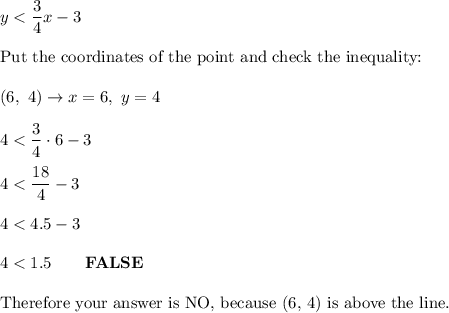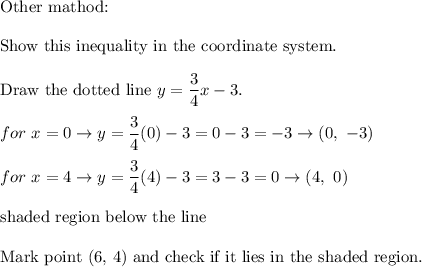Determine if the ordered pair (6, 4) is a solution to the inequality
[tex]y < \frac{3}{4}x...

Mathematics, 02.07.2019 02:30 alexisdiaz365
Determine if the ordered pair (6, 4) is a solution to the inequality

a. no, because (6, 4) is above the line
b. yes, because (6, 4) is below the line
c. yes, because (6, 4) is on the line
d. no, because (6, 4) is on the line

Answers: 2


Another question on Mathematics

Mathematics, 21.06.2019 18:30
Kayla wants to find the width, ab, of a river. she walks along the edge of the river 65 ft and marks point c. then she walks 25 ft further and marks point d. she turns 90° and walks until her location, point a, and point c are collinear. she marks point e at this location, as shown. (a) can kayla conclude that δ and δ are similar? why or why not? (b) suppose de = 15 ft. what can kayla conclude about the width of the river?
Answers: 2

Mathematics, 21.06.2019 23:10
Determine the required value of the missing probability to make the distribution a discrete probability distribution. x p(x) 3 0.23 4 ? 5 0.51 6 0.08 p(4) = nothing (type an integer or a decimal.)
Answers: 3


Mathematics, 22.06.2019 02:00
Study published in the journal of personality and individual differences found that adults with adhd displayed more creative achievement than those who didn't have the disorder. "for the same reason that adhd might create problems, like distraction, it can also allow an openness to new ideas," says holly white, assistant professor of cognitive psychology. "not being completely focused on a task lets the mind make associations that might not have happened otherwise." white and priti shah at the university of michigan gave 60 college students – half of them with adhd – a series of tests measuring creativity across 10 domains. the adhd group scored higher across the board. the adhd group showed more of a preference for brainstorming and generating ideas than the non-adhd group, which preferred refining and clarifying ideas. the adhd status of the participants was established by asking whether the individual had ever been clinically diagnosed with adhd/add. the tests of creativity were pencil-and-paper tasks administered in a laboratory setting. each of the ten scales was comprised of multiple questions, the scores on which were summed (e.g., writing creativity: "how many words can you make from the letters in the word 'psychology' invention creativity: "write down as many uses for a paper clip that you can think of.") this procedure does allow for a participant to be scored as showing no creativity under these conditions. a) state the research question in plain language (i wonder if is related to (1 point) b) state the null hypothesis (1 point) c) state the research hypothesis (1 point) d) is the research hypothesis directional or non-directional (1 point) e) name the predictor / independent variable f) give the operational definition of the predictor / independent variable g) evaluate the construct validity of the predictor / independent variable. (face, procedure, method-match) h) name the outcome / dependent variable i) give the operational definition of the outcome / dependent variable. j) evaluate the construct validity of the outcome / dependent variable. (face, procedure, method-match)
Answers: 1
You know the right answer?
Questions


English, 17.02.2021 02:20

Physics, 17.02.2021 02:20

Mathematics, 17.02.2021 02:20

Social Studies, 17.02.2021 02:20

Mathematics, 17.02.2021 02:20


Chemistry, 17.02.2021 02:20

Mathematics, 17.02.2021 02:20

Biology, 17.02.2021 02:20

Health, 17.02.2021 02:20

Biology, 17.02.2021 02:20

Mathematics, 17.02.2021 02:20



Mathematics, 17.02.2021 02:20

Mathematics, 17.02.2021 02:20

Mathematics, 17.02.2021 02:20

English, 17.02.2021 02:20



![Determine if the ordered pair (6, 4) is a solution to the inequality [tex]y < \frac{3}{4}x - 3[/](/tpl/images/0040/9077/d8f59.jpg)


